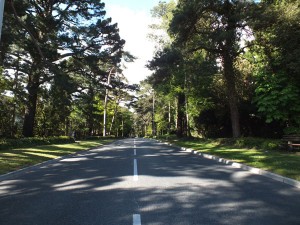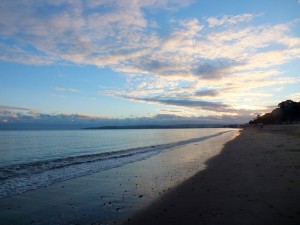
The Town in the Pine Woods
The Branksome Estate before development was a desolate place: “A tract of dark heathland”, wild, barren, and open. Bona fide travelers hurried across it to Poole or to Christchurch (The Duke of Rutland found it “a most dreary ride”); less legitimate users found the Heath’s emptiness quite an asset. The rocky coastline was ideal for smuggling, and a smugglers track ran to the sea at Branksome Chine. Legend had it that one particular well was full of brandy barrels, dumped in panic when the Coastguard arrived. The water acquired “some hidden virtue’ ‘, an old local remembered wistfully, and the well “was resorted to by neighbours far and wide.”
This part of the Heath was owned by an offshoot of the famous Bruce family of Scotland. It is to them that Branksome Park owes its beautiful pine plantations, and also its name. “Branksome” was the setting for Sir Walter Scott’s “Lay of the Last Minstrel”, one of the last century’s most popular poems. In 1833 Miss Bruce, clad in the Royal Bruce Tartan, opened a small pottery near Branksome Chine. The Poole band played “Scots Wha’ Hae”, the lady’s toast was drunk in whisky, (Miss Bruce clearly didn’t know about the smugglers’ well) and the labourers were regaled with boiled beef, plum pudding “and plenty of good ale”; but the venture was not a success.
Then, almost overnight, Bournemouth appeared – “a fairy place suddenly created by the stroke of a wand” as Thomas Hardy put it – and the fortunes of the Branksome Estate changed instantly. What is now Branksome Park was bought by Charles Packe, MP for South Leicestershire, in 1851; suburbs such as Branksome and Westbourne grew up elsewhere on the Estate.

‘The Avenue’ – originally the ‘drive’ to Branksome House but now the tree lined gateway to Branksome Park, Canford Cliffs & Sandbanks.
Packe, like the Bruces, felt the Scottish flavour of his new domain. He employed Scotland’s leading architect, William Burn, to build him a stone baronial mansion by the sea, which he called Branksome Tower (again borrowing from Scott’s poem). The 800-acre estate was laid out by Christopher Creeke, later to become one of Bournemouth’s most influential planners: it included such features as a Bathing House on the seafront, and a fifty-yard “rustic bridge” across Branksome Dene Chine. It was from this bridge that the young Winston Churchill was to fall, in 1893, while playing a game of chase with his brothers. He attributed his survival “to the surgeon’s art and to my own profound will-to-live”: if the bridge had been a little higher, then the course of British history would have been very different!
Charles Packe was also to play a role in the growth of Bournemouth. but at home in Branksome Park his main concern was for privacy. He built a wall around the estate, with a set of massive gates at the end of the main drive (now The Avenue), which joins the Poole Road at the old county boundary: hence the modern place-name County Gates. He later toyed with the idea of developing the western part of the estate, but at his death in 1867 Branksome Tower still stood in splendid isolation beneath the pines. Four years after his death, however, the Park was bought by Henry Bury, an energetic Northerner who lost no time in developing the estate. The wall was torn down, and with it the County Gates, though one of the lodges survived until 1975. The house became the Branksome Tower Hotel (advertised as being in Bournemouth but actually in Poole – just!) in the early 1890’s and operated through to 1973 when it was demolished to be replaced by a small estate of residential houses and apartment blocks – aptly names Branksome Towers.
Bury had the flair of a true town planner: modern Branksome Park is largely his creation. He built All Saint’s Church, Western Road at his own expense, to serve as a focus for the new development. He kept the beautiful Branksome Chine gardens as an open space, and laid down the important rule that each house was to have at least one acre of land: a measure that both preserved the rural atmosphere of Branksome Park and ensured that it would be an elite and prosperous neighbourhood. When he died in 1876, the area north and west of Western Road had already been laid out. An astute observer foresaw that Branksome Park would soon become “the most aristocratic part of Bournemouth”, and the mansions that Bury had hoped for were not long in appearing. One of the first was “Haileybury”, built in 1878 by the eminent architect Basil Champneys on the site of the modern Oratory Gardens estate. The northern portion of the estate, around Lindsay Road, was the first to be developed: as late as 1902 the western limits were described as “scarcely disturbed by the builder”. Mains sewage and street lighting arrived in the 1890’s, and by 1900 the area around Branksome Tower itself was being laid out in streets.
 Branksome Chine Gardens were restored and remodelled by Poole Council in 1930, who earned themselves the accolade “Gardeners of England” from the Minister who came to open them. Two years later, encouraged by the burgeoning popularity of the seaside, the Council proudly opened England’s first solarium at the mouth of the Branksome Chine. An idea imported from the Continent, sunbathers were offered the chance to absorb “the health-giving beams of the artificial sun” in the interior, or, if they preferred the real thing, to take tea beneath the “Vita-glass” of the tea lounge. The staid British public were unenthusiastic, however: “we had miscalculated the public taste,” confessed the Mayor of Poole. The solarium quickly became the admirable seaside cafe that it has been ever since, but over the door the curious can still admire the image of a portly lady in the sea, absorbing the rays of a ferociously red sun.
Branksome Chine Gardens were restored and remodelled by Poole Council in 1930, who earned themselves the accolade “Gardeners of England” from the Minister who came to open them. Two years later, encouraged by the burgeoning popularity of the seaside, the Council proudly opened England’s first solarium at the mouth of the Branksome Chine. An idea imported from the Continent, sunbathers were offered the chance to absorb “the health-giving beams of the artificial sun” in the interior, or, if they preferred the real thing, to take tea beneath the “Vita-glass” of the tea lounge. The staid British public were unenthusiastic, however: “we had miscalculated the public taste,” confessed the Mayor of Poole. The solarium quickly became the admirable seaside cafe that it has been ever since, but over the door the curious can still admire the image of a portly lady in the sea, absorbing the rays of a ferociously red sun.
Times change, and few of Branksome Park’s original mansions still remain. The only survival from Packe’s day is the little mausoleum at the head of the road to Branksome Dene Chine, in which he and his wife until recently were interred.
MORE RECENT TIMES.
Today Branksome Park is one of Poole’s most affluent and attractive areas sharing the postcode of BH13 with Canford Cliffs & Sandbanks. Hidden among the pine filled roads, many notable and cutting edge designed homes have recently been built in this extensive woodland area, known chiefly for its natural beauty, wide tree lined avenues, indigenous pines and abundance of colourful rhododendrons. It is also a conservation area, even though so few of the original buildings have survived. It is the Park itself that is special, as the authorities have realised; and a range of new safeguards have been introduced to preserve the luxurious foliage and landscape that make Branksome Park so unique. Some notable past residents of Branksome Park include Max Bygraves, J.R. Tolkien and Mantovani.
More info at link below.
https://www.opcdorset.org/BranksomeParkFiles/BranksomePark.htm
———————————————————————————
If you can add to this article or help us update it we would really appreciate hearing from you. Please read the ‘Contributors’ page found on lower navigation bar.